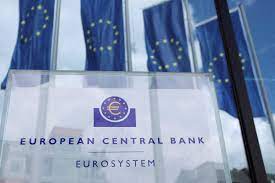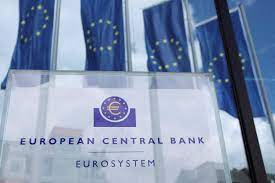
In the next years, the European Central Bank will keep setting a "floor" under market interest rates, but banks will have more control over the amount of liquidity they require, four people said.
In a new period where inflation is higher and the enormous amounts of money injected into the financial system through stimulus programmes over the past ten years are no longer necessary—and in some cases, are even having unintended consequences—the European Central Bank (ECB) is reevaluating how it sets short-term interest rates.
The mechanism has been straightforward for the majority of the last ten years: the ECB held interest rates at zero or below while flooding banks with excess cash through asset purchases and loans, encouraging them to lend and spurring then-too-low inflation.
As a result, banks were no longer required to borrow from the ECB, and the overnight rate that they charge one another was fixed at the rate that the ECB pays on deposits.
Now that interest rates are far higher than zero and enormous surplus reserves are superfluous, this structure needs to be changed. In fact, the ECB and several of the 20 central banks in the euro zone are suffering significant losses as a result.
The sources, who spoke on condition of anonymity due to the confidentiality of the discussions, claimed that policymakers gathering in Frankfurt last week decided that the European Central Bank (ECB) would maintain its "floor" system, in which the central bank essentially sets the lowest rate at which banks would lend to each other.
However, there is a crucial twist: the sources also stated that once the ECB has completed drawing down excess reserves in a few years, it would not determine on its own how much liquidity it offers the banking system.
Alternatively, policymakers decided that, in a manner akin to that of the Bank of England, commercial banks would assist in ascertaining that by borrowing the reserves they require from the ECB opens new tab.
According to the sources, the ECB will cut the rate on its weekly cash auctions, which is presently at 4.5%, and put it closer to its 4.0% deposit rate in order to facilitate this. This will make it less expensive for banks to borrow money.
This so-called "narrow corridor" would lessen the stigma and financial punishment for cash-strapped banks, especially during the changeover period.
Additionally, decision-makers decided to put up with minor oscillations in the benchmark Euro Short-Term Rate (ESTR), which is based on the ECB's own deposit rate and is used in the interbank market.
The sources also stated that they hope to unveil this new framework, which the market refers to as a "demand-driven floor," as early as the ECB's non-policy meeting on March 13.
The minimum reserve requirements for banks will stay at 1% of customer deposits for the time being. However, the sources claimed that some specific lawmakers are eager to make this change and would even suggest it.
According to the sources, there is ongoing discussion on the appropriate size of the European Central Bank's bond portfolio and whether it should be primarily composed of short-term securities or also longer-dated ones.
This conversation is mostly theoretical for the time being.
As the European Central Bank (ECB) now owns bonds valued at approximately 4.7 trillion euros ($5.1 trillion), the banking industry as a whole will have excess reserves until 2029, based on ECB estimates.
This is the outcome of the European Central Bank's (ECB) multiple bond-buying operations, which significantly raised the reserves in the banking system in an effort to combat low inflation and the financial effects of the COVID-19 epidemic.
In an earlier statement this month, ECB President Christine Lagarde stated that the bank will keep "a combination of a portfolio of bonds, but also lending operation of different maturities" on its balance sheet.
According to a staff report, the ECB might cut its bond holdings in half by the middle of 2026, but it would then need to start buying more bonds to support banks' lending to the economy.
Although the ECB's bank deposit rate is now at a record high, officials have made it clear that they plan to start lowering it later this year.
In a speech last year, ECB board member Isabel Schnabel was the first to propose that the euro zone's central bank could learn from the Bank of England.
(Source:www.reuters.com)
In a new period where inflation is higher and the enormous amounts of money injected into the financial system through stimulus programmes over the past ten years are no longer necessary—and in some cases, are even having unintended consequences—the European Central Bank (ECB) is reevaluating how it sets short-term interest rates.
The mechanism has been straightforward for the majority of the last ten years: the ECB held interest rates at zero or below while flooding banks with excess cash through asset purchases and loans, encouraging them to lend and spurring then-too-low inflation.
As a result, banks were no longer required to borrow from the ECB, and the overnight rate that they charge one another was fixed at the rate that the ECB pays on deposits.
Now that interest rates are far higher than zero and enormous surplus reserves are superfluous, this structure needs to be changed. In fact, the ECB and several of the 20 central banks in the euro zone are suffering significant losses as a result.
The sources, who spoke on condition of anonymity due to the confidentiality of the discussions, claimed that policymakers gathering in Frankfurt last week decided that the European Central Bank (ECB) would maintain its "floor" system, in which the central bank essentially sets the lowest rate at which banks would lend to each other.
However, there is a crucial twist: the sources also stated that once the ECB has completed drawing down excess reserves in a few years, it would not determine on its own how much liquidity it offers the banking system.
Alternatively, policymakers decided that, in a manner akin to that of the Bank of England, commercial banks would assist in ascertaining that by borrowing the reserves they require from the ECB opens new tab.
According to the sources, the ECB will cut the rate on its weekly cash auctions, which is presently at 4.5%, and put it closer to its 4.0% deposit rate in order to facilitate this. This will make it less expensive for banks to borrow money.
This so-called "narrow corridor" would lessen the stigma and financial punishment for cash-strapped banks, especially during the changeover period.
Additionally, decision-makers decided to put up with minor oscillations in the benchmark Euro Short-Term Rate (ESTR), which is based on the ECB's own deposit rate and is used in the interbank market.
The sources also stated that they hope to unveil this new framework, which the market refers to as a "demand-driven floor," as early as the ECB's non-policy meeting on March 13.
The minimum reserve requirements for banks will stay at 1% of customer deposits for the time being. However, the sources claimed that some specific lawmakers are eager to make this change and would even suggest it.
According to the sources, there is ongoing discussion on the appropriate size of the European Central Bank's bond portfolio and whether it should be primarily composed of short-term securities or also longer-dated ones.
This conversation is mostly theoretical for the time being.
As the European Central Bank (ECB) now owns bonds valued at approximately 4.7 trillion euros ($5.1 trillion), the banking industry as a whole will have excess reserves until 2029, based on ECB estimates.
This is the outcome of the European Central Bank's (ECB) multiple bond-buying operations, which significantly raised the reserves in the banking system in an effort to combat low inflation and the financial effects of the COVID-19 epidemic.
In an earlier statement this month, ECB President Christine Lagarde stated that the bank will keep "a combination of a portfolio of bonds, but also lending operation of different maturities" on its balance sheet.
According to a staff report, the ECB might cut its bond holdings in half by the middle of 2026, but it would then need to start buying more bonds to support banks' lending to the economy.
Although the ECB's bank deposit rate is now at a record high, officials have made it clear that they plan to start lowering it later this year.
In a speech last year, ECB board member Isabel Schnabel was the first to propose that the euro zone's central bank could learn from the Bank of England.
(Source:www.reuters.com)





